| Hokaiji Temple (宝戒寺) |
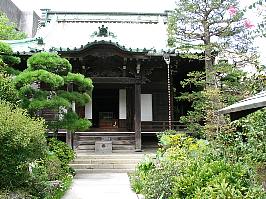 Full name: Kinryuzan Hokaiji (金龍山宝戒寺)
Full name: Kinryuzan Hokaiji (金龍山宝戒寺) Denomination: Tendai sect (天台宗)
Location: Four hundred meters north-east of JR Kamakura Station
History: The inscription on the stone monument at the entrance to Hokaiji Temple tells us that this property was once the residence of the Hojo clan (北条), who controlled the Kamakura government for generations. After the Hojo were defeated in 1333 by the imperial forces headed by Nitta Yoshisada (新田義 貞), the remaining members committed suicide. Later, Emperor Go-Daigo (後醍醐天皇, 1288-1339) ordered Ashikaga Takauji (足利尊氏, 1305-58) to build a temple here in the memory of the Hojo.
Grounds and structures: The Main Hall, open to worshippers, houses an image of Jizo Bosatsu in the center (designated an Important Cultural Property). This Jizo is popularly called Kosodate Kyoyomi Jizo (子 育経読地蔵), "Child-rearing and Sutra-chanting Jizo." A record found within the statue revealed that the image had been made in Kyoto in 1365 by Sanjo Hoin Ken'en (三条法印憲円), a priest. The two images of Taishakuten (帝釈天) and Bonten (梵天), that flank Jizo, are thought to have been carved around the same time. In front of them are statues of Juo (十王); to the right are images of Emma Daio (閻魔大王) and Hojo Takatoki, and to the left are images of Fudo Myoo (不動明王) and Juntei Kannon (准胝観音).
The temple also has an image of priest Yuiken (惟賢) (an Important Cultural Property), and a painting of Butsu Nehan Zu (仏涅槃図), in which Shakyamuni, in the state of Nirvana, is shown lying on his death bed surrounded by lamenting disciples, bosatsu, guardians, and even animals (designated an Important Cultural Property by Kanagawa Prefecture). Both are not open to the public view.
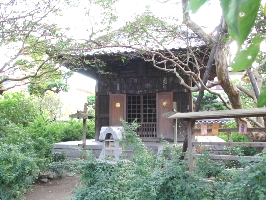
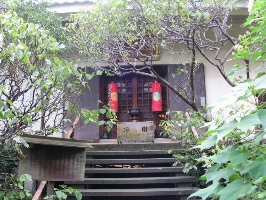
To the right of the main hall are two halls. One is the Taishido Hall (太子堂) dedicated to Shotoku Taishi (聖徳太子, 574-622), a statesman and the founder of Horyuji Temple (法隆寺) in Nara, depicted here as a monk The other is a hall dedicated to Kangiten (歓喜天), a secret object of worship. Coming from one of the Hindu divinities, this was joined as a Buddhist protector. Kangiten is generally depicted as figures, a male and a female with elephant heads, tightly embracing each other. Thus Kangiten is widely worshipped for wealth, conjugal harmony, childbirth, and even cure of diseases.
Hokaiji Temple is often known as Hagidera (萩寺) or "Bush-Clover Temple," referring to the abundance of Japanese bush clover (hagi), that come into flower in the fall.
| Toshojibashi Bridge (東勝寺橋) |
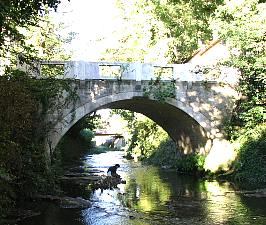 Toshobashi Bridge spans the Namerigawa River on the way to the former site of Toshoji Temple. This
ferroconcrete bridge was built after the Great Kanto Earthquake of 1923. Its beautiful shape matches the
surroundings and contributes to the peaceful atmosphere. The best time to visit this bridge is in the fall
when the leaves have turned red and gold.
Toshobashi Bridge spans the Namerigawa River on the way to the former site of Toshoji Temple. This
ferroconcrete bridge was built after the Great Kanto Earthquake of 1923. Its beautiful shape matches the
surroundings and contributes to the peaceful atmosphere. The best time to visit this bridge is in the fall
when the leaves have turned red and gold. In 2001, the bridge was designated an Important Structure of Scenic Beauty. At the foot of the bridge, a stone monument marks the site of the residence of Aoto Fujitsuna, a warrior of the mid-13th century.
There is a story connected with this warrior. One evening, Fujitsuna accidentally dropped some small change in the river around here. Most people would not have taken the trouble to try to retrieve such a small amount, but he was determined to recover every last coin. People laughed at his seeming stupidity, saying that he was "penny-wise and pound-foolish." In reply, Fujitsuna said, "You don't understand the real meaning of loss." "The coins," he continued, "if left in the river, would be lost for good. But I spent that money on torches and it went into the pocket of the merchant. From there, it will pass from person to person."
| The site of Toshoji Temple (東勝寺跡) |
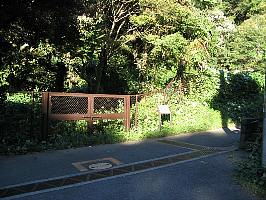 Toshoji Temple was the final refuge of the Hojo clan, who destroyed themselves here in 1333 after
being defeated by the forces of Nitta Yoshisada. Hojo Takatoki, the head of the Kamakura government,
together with his family and his men, fled from their residences in the grounds of Hokaiji Temple to this
place which was their family temple. Takatoki and some eight hundred followers all committed suicide. The
site is significant in that it represents the place where the Kamakura government came to an end after
ruling for 150 years.
Toshoji Temple was the final refuge of the Hojo clan, who destroyed themselves here in 1333 after
being defeated by the forces of Nitta Yoshisada. Hojo Takatoki, the head of the Kamakura government,
together with his family and his men, fled from their residences in the grounds of Hokaiji Temple to this
place which was their family temple. Takatoki and some eight hundred followers all committed suicide. The
site is significant in that it represents the place where the Kamakura government came to an end after
ruling for 150 years.
| The site of the Utsunomiya-zushi bakufu (宇都宮幕府跡) |
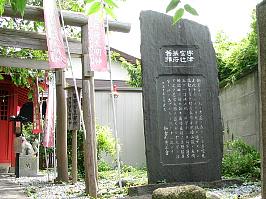 A stone monument marking the site of the Utsunomoya-zushi bakufu stands a little set back behind the
Kamakura-bori Kaikan building on the Wakamiya-oji avenue. In 1180, Minamoto no Yoritomo entered Kamakura
and first established the government at Okura, one kilometer northeast from here. The Okura bakufu lasted
until 1225. After the death of Yoritomo, his widow Masako virtually controlled the government, because
their two sons who succeeded him were incompetent. After the death of Masako in 1225, the government
headquarters were moved to this site in the same year. It was named Utsunomiya-zushi bakufu and continued
here for 11 years until another transfer. The third venue was called Wakamiya-oji bakufu.
A stone monument marking the site of the Utsunomoya-zushi bakufu stands a little set back behind the
Kamakura-bori Kaikan building on the Wakamiya-oji avenue. In 1180, Minamoto no Yoritomo entered Kamakura
and first established the government at Okura, one kilometer northeast from here. The Okura bakufu lasted
until 1225. After the death of Yoritomo, his widow Masako virtually controlled the government, because
their two sons who succeeded him were incompetent. After the death of Masako in 1225, the government
headquarters were moved to this site in the same year. It was named Utsunomiya-zushi bakufu and continued
here for 11 years until another transfer. The third venue was called Wakamiya-oji bakufu.In those days, the word "zushi" in Utsunomiya-zushi meant a convenient pathway set back from the main road. Many paths had the suffix, "zushi," including Utsunomiya-zushi, Dengaku-zushi and Daigaku- zushi.
| The Site of the Wakamiya-oji bakufu (若宮大路幕府跡) |
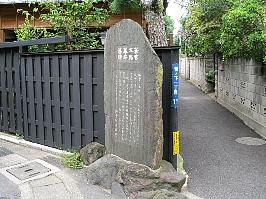 The stone tablet standing along this narrow pathway says this was the site of the shogunate
headquarters at Wakamiya Oji. The place looks too insignificant to have merited such an important function.
When Minamoto no Yoritomo first took over Kamakura, he set up his shogunate in the Okura area, just
northeast of this place. After his death, the actual control of government was taken over by his wife
Masako. When she died, the shogunate building was moved to the Utsunomiya-zushi, about 300 meters to the
south. The headquarters were moved later to this site, where it remained until Kamakura fell to Nitta
Yoshisada in the early 14th century.
The stone tablet standing along this narrow pathway says this was the site of the shogunate
headquarters at Wakamiya Oji. The place looks too insignificant to have merited such an important function.
When Minamoto no Yoritomo first took over Kamakura, he set up his shogunate in the Okura area, just
northeast of this place. After his death, the actual control of government was taken over by his wife
Masako. When she died, the shogunate building was moved to the Utsunomiya-zushi, about 300 meters to the
south. The headquarters were moved later to this site, where it remained until Kamakura fell to Nitta
Yoshisada in the early 14th century.| The former residence of Osaragi Jiro (大仏次郎邸跡) |
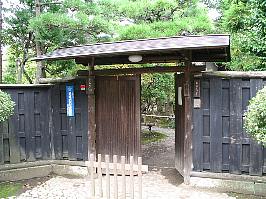 This was the home of the novelist, Osaragi Jiro. He was born in Yokohama in 1897 and as a young man,
he lived in a house behind the grounds of the Great Buddha in Hase, where he wrote his popular historical
novel, Kurama Tengu. In 1929 he moved here to Yukinoshita where he lived until his death in 1972. Osaragi
was one of the central literary figures in Kamakura and was active in the movement to preserve Kamakura's
natural environment. His ashes are buried at Jufukuji Temple.
This was the home of the novelist, Osaragi Jiro. He was born in Yokohama in 1897 and as a young man,
he lived in a house behind the grounds of the Great Buddha in Hase, where he wrote his popular historical
novel, Kurama Tengu. In 1929 he moved here to Yukinoshita where he lived until his death in 1972. Osaragi
was one of the central literary figures in Kamakura and was active in the movement to preserve Kamakura's
natural environment. His ashes are buried at Jufukuji Temple.
| Kamakura-bori Assembly Hall (鎌倉彫会館) |
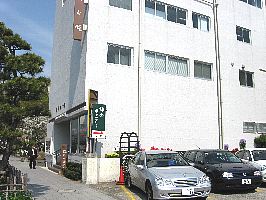
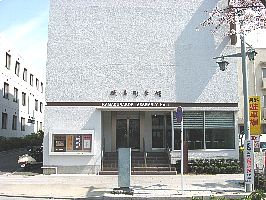
Location: Situated on the right side of Wakamiya-oji Street and close to the Second Gate of Tsurugaoka Hachimangu Shrine.
Facility: The Kamakura-bori Kaikan newly opened in 2006 to provide information and materials relating to the art of Kamakura carving. Here the visitor can learn about every aspect of Kamakura-bori, its history, the processes involved, and can admire some of the fine historical and modern masterpieces that are displayed in its showcases. Videos showing the carving and lacquering processes can be viewed on request, and booklets in Japanese and English are available.
Classes for Kamakura-bori carving are provided: the three-year basic course and advanced one are open.
Hours: 9:30 - 17:00 (Last Entry 16:30)
Tel: 0467-25-1500
| Myoryuji Temple (妙隆寺) |
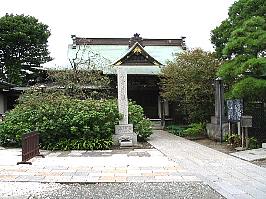 Full name: Eishozan Myoryuji (叡昌山妙隆寺)
Full name: Eishozan Myoryuji (叡昌山妙隆寺) Denomination: Nichiren sect (日蓮宗)
Location: Three hundred meters north-eat of JR Kamakura Station.
History: The area is said to have once been occupied by residences of the descendants of the Chiba clan (千葉), influential retainers in the Kamakura period. Tradition at the temple maintains that it was built by Nichiei (日英), who in 1385 was invited by Chiba Tanesada (千葉胤貞) to serve as the founding priest.
Ground and structures: The Main Hall houses images of Nichiren (日蓮, 1222-82), Nisshin (日親), the second head priest, and Shaka Nyorai. The hall this side on the right of the Main Hall houses a statue of Jurojin (寿老人), one of the Seven Lucky Gods of the Kamakura-Enoshima area, who brings longevity as well as safety and health to worshipers. Another stone statue of Jurojin, attended by a deer, stands in front of the entrance to the temple office on the left.
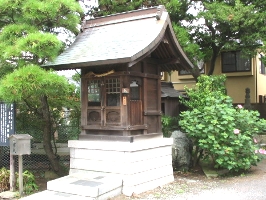
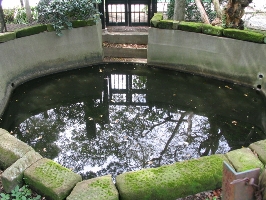
On the right side of the grounds are a pond called Chinoike (血の池), "Blood Pond," where Nisshin trained himself rigorously. (See ‘Story')
Further along on the same side is a small hall called Nisshindo (日親堂), which houses a stone image of Nisshin himself.
Story: At the age of 21, Nisshin told himself that he had to be strong enough to endure trials of any kind if he was to spread the teachings of Buddha. To prepare himself, achieve this, he would first bathe in the pond on the grounds here and chant sutras, then paint a mandala in India ink mixed with blood obtained by pulling out his nails. While chanting, he would also plunge his hands into boiling water. Later, in Kyoto, he wrote out his philosophy in a book called Rissho Chikokuron (立正治国論) and submitted the dissertation to the sixth shogun, Ashikaga Yoshinori (足利義教, 1394-1441) as a means of correcting the shogun's policy. In response, he was arrested and punished by having a heated pot fitted on his head. This earned him the nickname, Nabekamuri Nisshin, literally "Pot-Wearing Nisshin."
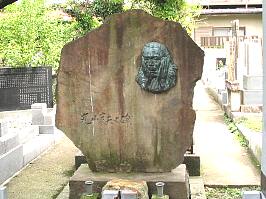
On the right side of the main hall is a stone monument dedicated to the actor Maruyama Sadao (丸山定 夫, 1901-45).
| The site of Nichiren's Street Preaching (日蓮上人辻説法跡) |
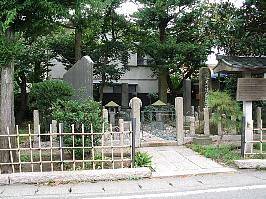 Nichiren, the founder of the Nichiren sect of Buddhism, came to Kamakura to spread his teaching based
on his own interpretation of the Hokekyo (Lotus) sutra. This site commemorates his street preaching
activities. He would stand at crowded street corners and ardently preach his own doctrine. Even from those
days, this street was called Komachi-oji and was a busy area lined with shops and stalls.
Nichiren, the founder of the Nichiren sect of Buddhism, came to Kamakura to spread his teaching based
on his own interpretation of the Hokekyo (Lotus) sutra. This site commemorates his street preaching
activities. He would stand at crowded street corners and ardently preach his own doctrine. Even from those
days, this street was called Komachi-oji and was a busy area lined with shops and stalls.
| Hiruko Jinja Shrine (蛭子神社) |
Dedicated deity: Omunachi no Mikoto (大己貴命) Location: Two hundred meters east of JR Kamakura Station. History: In the early Meiji period (1867-1912), the shrine gained its present name of Hiruko Jinja and is the tutelary shrine of the Komachi area. In Japanese mythology, Hiruko was the first offspring of Izanagi ( 伊奘諾) and Izanami (伊奘冉). Izanagi and Izanami were progenitors of the Japanese archipelago. Hiruko, in time, came to be worshipped as Ebisu, one of the seven deities of good fortune. "Ebisu" is rendered in many ways in Japanese writing: 恵比須、恵比寿、夷、戎、etc. Grounds and structures: The Main Hall, leveled by the Great Kanto Earthquake of 1923, was rebuilt in 1933. An annual festival is held on September 15.
| Daigyoji Temple and Ubusumereijin (大功寺と産女霊神) |
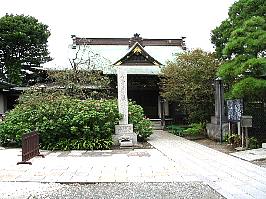 This temple was originally located in Juniso, in the eastern part of Kamakura. In the late 12th
century, Minamoto no Yoritomo planned his military operations at the temple there and achieved a sweeping
victory. As a sign of gratitude he changed the temple name to the present one, meaning "Great Achievement.
"
This temple was originally located in Juniso, in the eastern part of Kamakura. In the late 12th
century, Minamoto no Yoritomo planned his military operations at the temple there and achieved a sweeping
victory. As a sign of gratitude he changed the temple name to the present one, meaning "Great Achievement.
"The main image is Ubusumereijin, known popularly as Ommesama, the guardian of expectant mothers, who come here with their husbands and family members to pray for a safe and easy birth.
Story: Omme-sama, responsible for securing safe childbirth, is the popular name for this temple. Its origin dates back to 1536 when the fifth priest, Nitto (日棟) met the wife of a warrior, Akiyama Kageyu (秋山勘解由). On an early morning Nitton was about to cross the Namerigawa River (滑川) nearby. He saw a woman sobbing on the riverbank, hair disheveled and hugging a very thin baby to her breast. "What troubles you, woman?" Nitto asked. The woman answered, "I am the wife of Akiyama Kageyu ( 秋山勘解由). I died giving birth. Every day I have tried to cross this river, but cannot. Help me, I beseech you." Nitto answered, "Have faith in Buddha, good woman, and chant sutras everyday. That will free you from your suffering." He then began to chant, and when finished, he turned to the woman, but she was gone.
A few days after, Nitto was approached by a beautiful woman, who said, "I followed your advice, chanted sutras, and now my sufferings are gone. As a token of my gratitude, I have brought money that I saved while alive. Please make full use of it," she continued, "to build a pagoda to save women who suffer in childbirth." Nitto then set about building a pagoda dedicated to her as Ubumereijin (産女霊神), responsible for securing safe childbirth, on the grounds of Daigyoji Temple. In time, Ubumereijin came to be called Omme-sama, and even today many expectant mothers, escorted by their husbands or other family members, come to pray for a safe and easy childbirth.
|
Hongakuji Temple and the tomb of Masamune, a celebrated swordsmith (本覚寺と刀工正宗の墓) |
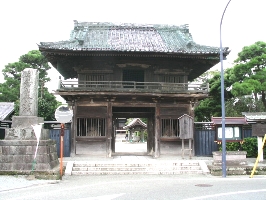
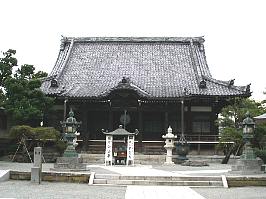
Full name: Myogonzan Hongakuji (妙厳山本覚寺)
Denomination: Nichiren sect (日蓮宗)
Location: One hundred and fifty meters south-east of JR Kamakura Station.
History: Hongakuji Temple was founded in 1436 by Ichijoin Nisshutsu (一乗院日出). Tradition tells us that Nisshutsu was born at Mishima (now part of Shizuoka Prefecture) and was first a scholar, then later a priest of the Nichiren sect. When he came to Kamakura, he lived here at Ebisudo Hall (夷堂) and tried to propagate his teachings. He faced harsh and merciless opposition from other sects, and the result of this was an order for an arrest by Ashikaga Mochiuji (足利持氏, 1398-1439), Kamakura's kubo (Governor-general of the Kanto Region). Nisshutsu was about to be killed at the execution site. However, according to legend, Mochiuji got a divine message from the god Ebisu, which brought about a pardon. So impressed was Mochiuji by this occurrence that he had a temple built on the site where Ebisudo Hall was situated, and dedicated it to Nisshutsu.
The second head priest was Nitcho (日朝, 1421-1500). His relationship with Nisshutsu began before the latter's departure for Kamakura, because Nisshutsu, while still in Mishima, had had a dream in which he was urged to go to Usami (宇佐美), some 20 kilometers south-east of Mishima. Nisshutsu met a boy named Kyochomaru (鏡澄丸). Nisshutsu accepted him as a disciple and Kyochomaru became the second head priest of Hongakuji Temple under the name of Nitcho. Because he was so highly revered, he was called a reincarnation of Nichiren and for that reason, even today, Hongakuji Temple is popularly referred to as Nitcho-Sama (日朝 さま).
He left for Mt. Minobu (身延山, now in Yamanashi Prefecture) to become Head Priest at Kuonji Temple ( 久遠寺), the head temple of the Nichiren sect. He then had a portion of Nichiren's ashes taken to Kamakura, establishing a second head temple so that worshippers could be provided easier access here instead of having to travel all the way to Minobu. Thus the temple is also called Higashi Minobu (東身延), "East Minobu."
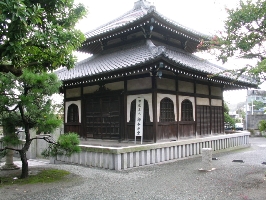
Grounds and structures: The two-story Niomon Gate (仁王門), built in the Edo period (1603-1867), is the main entrance to the temple grounds. In each recess of the gate is a fierce-looking Nio (仁王), a guardian deity of a temple. The Nio on the right (as you face them) has his mouth open so that he appears to be uttering "ah (阿)," which means "the beginning. The other Nio, however, has his mouth closed and is uttering "un (吽)," which means "the ending."
The Main Hall imposingly stands ahead, with Ebisudo Hall this side on the right. Next to it is a belfry. Soshi Bunkotsudo Hall (祖師分骨堂), which houses part of the remains of Nichiren, is to the right of the Main Hall. In the Main Hall is the chief image, Shaka Nyorai (釈迦如来), flanked by Monju Bosatsu (文殊菩薩) and Fugen Bosatsu (普賢菩薩), and an image of Nichiren. In addition, there is an image of Nisshutsu on the left end of the altar and an image of Niccho on the right.
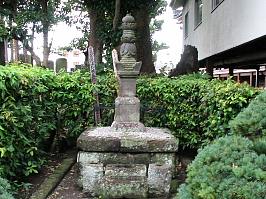 In the graveyard to the left of the Main Hall is a tombstone said to be that for Okazaki Goro
Masamune (岡崎五郎正宗), a celebrated swordsmith of the late Kamakura period.
In the graveyard to the left of the Main Hall is a tombstone said to be that for Okazaki Goro
Masamune (岡崎五郎正宗), a celebrated swordsmith of the late Kamakura period.When Masamune, still a boy, came to Kamakura, Nichiren (日蓮, 1222-82) had already taken up residence in Ebisudo Hall (夷堂). Masamune's father brought Masamun to Nichiren to learn his teachings, and in return Nichiren gave the boy a new name Masamune, which implies the rightness of the teachings of Nichiren himself. Because of this connection, the tombstone believed to be that for Masamune is within the grounds of Hongakuji Temple (本覚寺) .
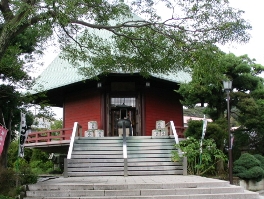 Ebisudo Hall, rebuilt in 1981, is dedicated to Ebisujin (夷神), one of the seven gods of good luck.
Originally it was built by order of Yoritomo (源頼朝, 1147-99) to protect the government from evil effects,
because this area, when facing the grounds of the bakufu in Okura, was in an inauspicious direction of the
compass: the devil's rear gate.
Ebisudo Hall, rebuilt in 1981, is dedicated to Ebisujin (夷神), one of the seven gods of good luck.
Originally it was built by order of Yoritomo (源頼朝, 1147-99) to protect the government from evil effects,
because this area, when facing the grounds of the bakufu in Okura, was in an inauspicious direction of the
compass: the devil's rear gate.This concept of an evil direction originated in ancient Chinese fortune-telling, in which the northeast and southwest sectors are called kimon (鬼門) and urakimon (裏鬼門) respectively, and are the entry and departure points for evil spirits; thus, any activity there must be avoided. Even today, some people attribute misfortune or illness to a neglect of this belief. Story: Hongakuji, we are told, is the place to visit for those who have eye problems. Nitcho once said, "Anyone who has contracted a disease of the eye should call upon me in prayer, for I will then put an end to the affliction. When I myself suffered from an eye disease, I overcame it by chanting the Hokekyo Sutra (法華経)." This story can also be found among Kabuki dramas.
| Ebisudobashi Bridge (夷堂橋) |
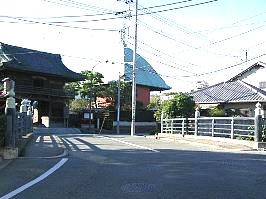 The Ebisudobashi Bridge spans the Namerigawa River and was known as one of the ten major bridges of
old Kamakura. The inscription on the stone monument tells us that the bridge once bordered the bustling
business area of Omachi and the residential area of Komachi.
The Ebisudobashi Bridge spans the Namerigawa River and was known as one of the ten major bridges of
old Kamakura. The inscription on the stone monument tells us that the bridge once bordered the bustling
business area of Omachi and the residential area of Komachi.The river running under the bridge is Namerigawa. It has as many as six names as it winds its way from its source in the hills of Juniso to its mouth at Zaimokuza Beach. It is called Kurumigawa around the upper part of Jomyoji; Namerigawa, around the mouth of the river; Zazengawa near the site of the priest Mongaku's residence; Ebisudogawa around the Ebisudobashi Bridge; Sumiurigawa around Omachi; and the Emmagawa around Zaimokuza. Whatever the names, Namerigawa is the only one that need be remembered today.